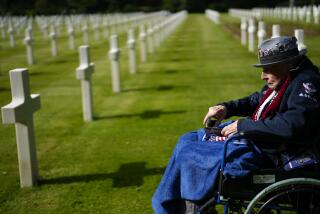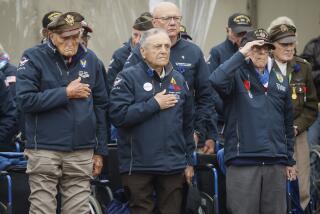U.S. and Soviet Vets Muster at Elbe for Peace
- Share via
TORGAU, East Germany — Trading souvenirs and memories and calling for renewal of the friendship that flickered briefly between their two countries 40 years ago, Soviet and American war veterans returned here Thursday to mark the day they linked up on the Elbe River in the fading days of World War II.
Older and grayer, with ruddied faces but untarnished ideals, the veterans issued a joint call for peace--a rekindling of the “spirit of the Elbe.” Then they drank and ate together much as they did 40 years before.
For the soldiers of the Red Army, pressing Nazi Germany from the east, and American forces pushing from the west, the linkup meant their own survival in the war, and for Europeans it signaled the death knell for Adolf Hitler’s Third Reich.
‘Feelings Were the Same’
“We spoke different languages, but our feelings were the same,” Joseph Slopek of Munro Falls, Ohio, recalled of the day that he and his American buddies drank vodka, danced and took their “oaths of the Elbe” to never fight again.
On Thursday, about 300 Soviet and American veterans rededicated themselves to that oath during commemorative ceremonies that drew much of the town’s population, East German dignitaries and a contingent of Soviet officers.
“We reaffirm our pledge made on April 25, 1945, to friendship between the United States and the Soviet Union so there is no more war,” said William Beswick, vice chairman of the U.S. Army’s 69th Division’s Veterans Assn.
But the absence of official American participation at the celebration was an unspoken reminder of the reality of U.S.-Soviet ties.
Protest Over Killing
The United States did not send an official representative in protest of the killing last month of U.S. Army Maj. Arthur D. Nicholson Jr. by a Soviet sentry in East Germany.
Moscow has reportedly expressed regret in private for the incident but has not issued a formal apology.
“I kind of wish they (the United States) had been here, but I understand about Maj. Nicholson,” said Dr. William Robertson, a Los Angeles neurosurgeon who, as a young lieutenant, was the first American to make contact with the Soviets at Torgau. “It is a difficult thing.”
The tense nature of U.S.-Soviet relations left younger Red Army officers attending the commemoration uncertain about how to react to the American veterans.
When Peter Sitnik, a former interpreter for the U.S. Army along the Elbe, pulled an unsuspecting Soviet lieutenant in front of the battery of television cameras and then draped his arms around him, the young officer stood horrified and uncertain before deciding on a fleeting smile.
‘Possible to Get Along’
The veterans themselves, however, had no such inhibitions.
Leroy Wolins, vice commander of the Veterans for Peace, a second U.S. group here, noted that it took only a few minutes for the Soviets and Americans to agree on a joint statement for the meeting.
“Today is a reminder that it is possible to get along,” he said. “This won’t solve world problems today, but it can establish the atmosphere to solve them tomorrow.”
At a lunchtime reception, veterans mixed freely, exchanging tales of the day 40 years before.
Albert Honyak, now a Cleveland plumbing contractor, recalled dancing with a Russian woman who was conspicuous, he told a Soviet veteran, for the machine pistol she carried and her especially robust figure.
“I think she still lives in Moscow,” his listener replied with a laugh.
Dollar for Ruble
Slopek exchanged a dollar bill for a one-ruble coin with a former Soviet captain, an exchange that he had also carried out in his first meeting with a Russian.
During an hour of formal speeches, Robertson and Alexander Silvashko, the Soviet lieutenant he first met at the eastern edge of a bridge over the Elbe here 40 years before, stood next to each other and chatted through an interpreter.
Since their first meeting, Robertson had met Silvashko twice in the Soviet Union for anniversary-related celebrations, including a recent trip when he was greeted by a group of children from the secondary school near Minsk where Silvashko is the principal.
Torgau itself treated the reunion as a holiday, with thousands of its citizens crowding around the small plaza in front of the U.S.-Soviet monument and lining the bridge that brought the two armies together.
Flags and Banners
Flags and banners carrying peace slogans in English, Russian and German were hung from trees and buildings. Schools were dismissed, and children carrying signs calling for peace walked through the town.
“We want no space weapons,” one sign read.
Soviet and American veterans also joined in paying tribute to the memory of Joseph Polowsky, a GI, whose meeting with Soviet troops a few miles south of Torgau, also on April 25, transformed his life into a mission for Soviet-American friendship.
“We drank and there were accordions and balalaikas and music and dancing,” Polowsky, a private first class with the 69th Infantry Division, recalled years later in a written account. “They played American songs.”
Formal Call for Peace
A Chicago taxicab driver of Russian descent, Polowsky later drafted the “oath of the Elbe,” a formal call for peace that captured the spirit of his informal encounter with Soviet troops.
He subsequently met with Soviet Premier Nikita S. Khrushchev and petitioned world leaders for an end to the arms race. When he died of cancer in November, 1983, his request for burial at Torgau was fulfilled.
On Thursday, with his 25-year-old son, Theodore, looking on, the veterans laid a wreath at Polowsky’s grave.
“I always felt that American-Russian relations were plagued by bad luck right from the beginning,” he once said. “If we had gotten publicity with the oath of the Elbe, there would have been a certain depth in the feelings.”
More to Read
Sign up for Essential California
The most important California stories and recommendations in your inbox every morning.
You may occasionally receive promotional content from the Los Angeles Times.













